Vibrations of Misaligned Rotor System with Hysteretic Friction Arising from Driveshaft–Stator Contact under Dispersed Viscous Fluid Influences
Abstract
1. Introduction
2. Modelling Approach and Governing Equation
2.1. Establishment of the Cardan Joint Perturbation Equation
2.2. Mathematical Modelling of the System
3. The Hydrodynamic Forces and Introduction into the Model and Solution
4. Contact Region and Excitation Forces Inside the Viscous Fluid
5. Model Parameters and Numerical Simulation
5.1. Vibration Analysis of the Unbalanced Rotors System
5.2. Vibration Response of the Coupled System with Rubbing Fault
5.3. Influence of Fluid Forces on the Vibration Response of the Rubbing Coupled System
6. Conclusions
- The normal operation of the rotating machine results from an appropriate torque/load unbalance and consists of the main rotative motion of the driveshaft performed with an appropriate rotational speed. This main motion of unbalanced rotors was accompanied by a limited level of lateral/torsional vibrations of both rotors and a limited level of excitation of nonstationary (rotating) parts.
- With continuous rubbing contact, the state of motion of the system becomes more complex; the stable region first increases and then almost leads to a chaotic state. The complex and aperiodic motion frequently alternate, and the amplitude of the response gradually increases.
- When centrifugal fluid forces exist, the response of the coupling system displays many obvious discontinuous amplitude jumps. As the speed variation increases, the system transits from an almost chaotic state to aperiodic motion at an acceptable rotating machine speed.
- The relative differences of the coupled system can be caused by the rotational speed increment. This means that, most likely, the exact resonance frequency of the rotor system in the viscous fluid is well hit with a diminished amplitude from the real resonance peak.
- The Hooke’s joint significantly influences the overall dynamic characteristics of the connected rotor system where the monitoring of the highest vibration motion of the driveshaft to the driven shaft is drastically damped.
- The 3-D frequency spectrum profile is a more efficient tool than the FFT to reveal the nonlinear and nonstationary nature of the excitation frequencies produced by the driveshaft in a fluid medium whose estimation of speed and frequency are more localized for multiple rotor faults.
Author Contributions
Funding
Data Availability Statement
Acknowledgments
Conflicts of Interest
References
- Alugongo, A.A. Parametric excitation and wavelet transform analysis of a ground vehicle propeller shaft. J. Vib. Control. 2014, 20, 280–289. [Google Scholar] [CrossRef]
- Tchomeni, B.X.; Alugongo, A. Theoretical and experimental analysis of an unbalanced and cracked cardan shaft in the vicinity of the critical speed. Math. Model. Eng. 2020, 6, 34–49. [Google Scholar] [CrossRef]
- Didier, J.; Faverjon, B.; Sinou, J.J. Study of the non-linear dynamic response of a rotor system with faults and uncertainties. J. Sound Vib. 2012, 331, 671–703. [Google Scholar] [CrossRef]
- Fu, C.; Yang, Y.; Lu, K.; Gu, F. Nonlinear vibration analysis of a rotor system with parallel and angular misalignments under uncertainty via a Legendre collocation approach. Int. J. Mech. Mater. Design. 2020, 16, 557–568. [Google Scholar] [CrossRef]
- Xia, Y.; Pang, J.; Yang, L.; Zhao, Q.; Yang, X. Nonlinear numerical and experimental study on the second-order torsional and lateral vibration of driveline system connected by Cardan joint. J. Vib. Control. 2020, 26, 540–551. [Google Scholar] [CrossRef]
- Shimogo, T.; Kazao, Y. Critical speed of rotor in a liquid. Bull. JSME 1982, 25, 277–283. [Google Scholar] [CrossRef][Green Version]
- Ibrahim, R.A.; Latorre, G. Experimental investigation of dynamic parameters of viscous fluids in unsteady flow. J. Press. Vessel. Technol. 1988, 110, 29–35. [Google Scholar] [CrossRef]
- Behera, R.K.; Parhi, D.R.; Sahu, S.K. Vibration analysis of a cracked rotor surrounded by viscous liquid. J. Vib. Control. 2006, 12, 465–494. [Google Scholar] [CrossRef]
- Ibrahim, R.A. Liquid Sloshing Dynamics: Theory and Applications; Cambridge University Press: Cambridge, UK, 2005. [Google Scholar]
- Tchomeni, B.X.; Sozinando, D.F.; Alugongo, A.A. Influences of hydrodynamic forces on the identification of the rotor-stator-rubbing fault in a rotating machinery. Int. J. Rotating Mach. 2020, 2020, 1–18. [Google Scholar] [CrossRef]
- Tchomeni, B.X.; Alugongo, A.A. Modelling and numerical simulation of vibrations induced by mixed faults of a rotor system immersed in an incompressible viscous fluid. Adv. Mech. Eng. 2018, 10, 1687814018819341. [Google Scholar] [CrossRef]
- Purohit, A.; Darpe, A.K.; Singh, S.P. Experimental investigations on flow-induced vibration of an externally excited flexible plate. J. Sound Vib. 2016, 371, 237–251. [Google Scholar] [CrossRef]
- Purohit, A.; Darpe, A.K.; Singh, S.P. A study on aerodynamic sound from an externally excited flexible structure in flow. Comput. Fluids. 2014, 103, 100–115. [Google Scholar] [CrossRef]
- Song, M.-H.; Nam, T.-K.; Lee, J.-U. Self-excited torsional vibration in the flexible coupling of a marine propulsion shafting system employing Cardan shafts. J. Mar. Sci. Eng. 2020, 8, 348. [Google Scholar] [CrossRef]
- Seherr-Thoss, H.C.; Schmelz, F.; Aucktor, E. Universal Joints and Driveshafts: Analysis, Design, Applications, 2nd ed.; Springer Science & Business Media: Berlin, Germany, 2006. [Google Scholar]
- Beatty, R.F. Differentiating rotor response due to radial rubbing. J. Vib. Acoust. 1985, 107, 151–160. [Google Scholar] [CrossRef]
- Burkhalter, R.; Mazziotti, P.J. The Low Silhouette Driveline; SAE International: Warrendale, PA, USA, 1956; p. 691. [Google Scholar]
- Chu, F.; Lu, W. Experimental observation of nonlinear vibrations in a rub-impact rotor system. J. Sound Vib. 2005, 283, 621–643. [Google Scholar] [CrossRef]
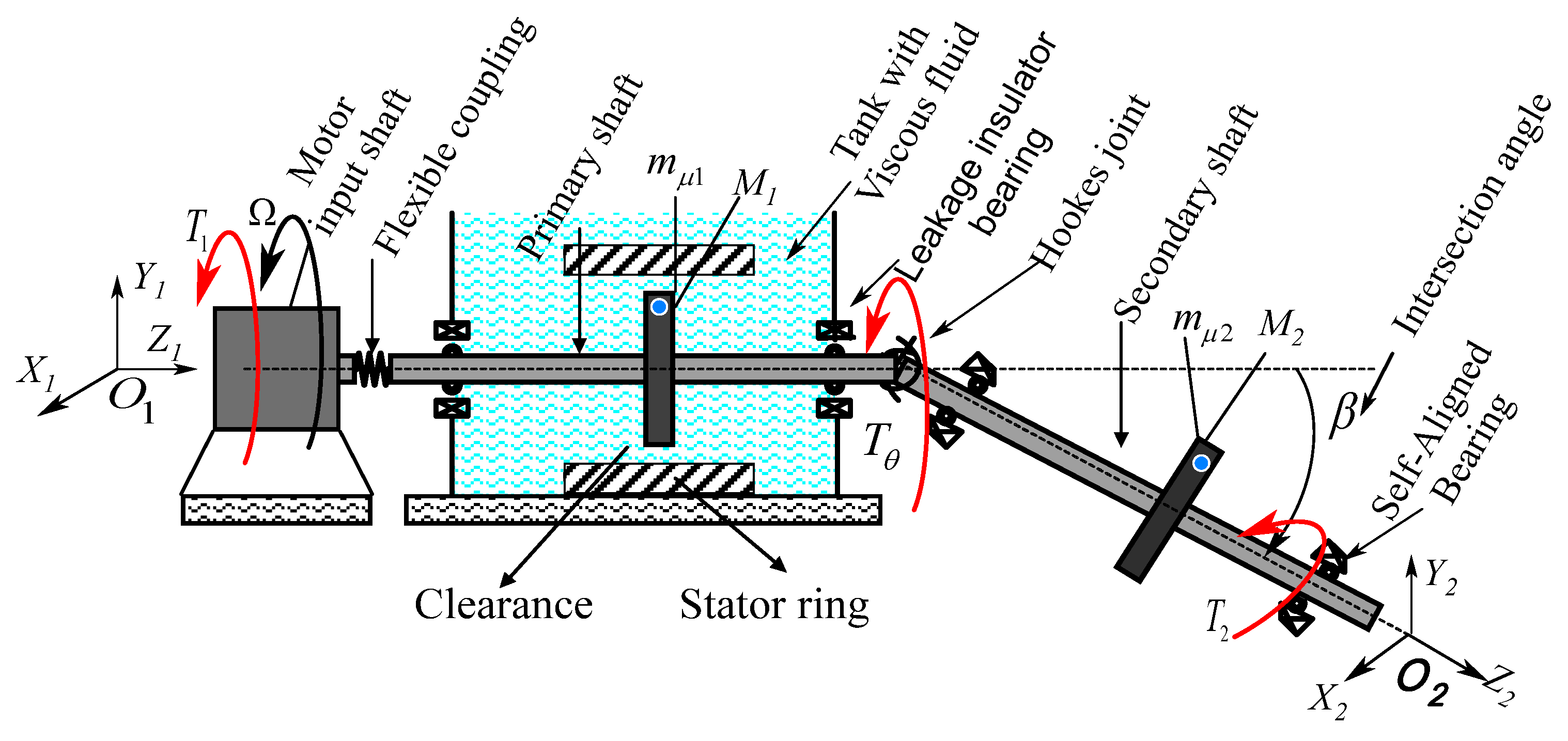
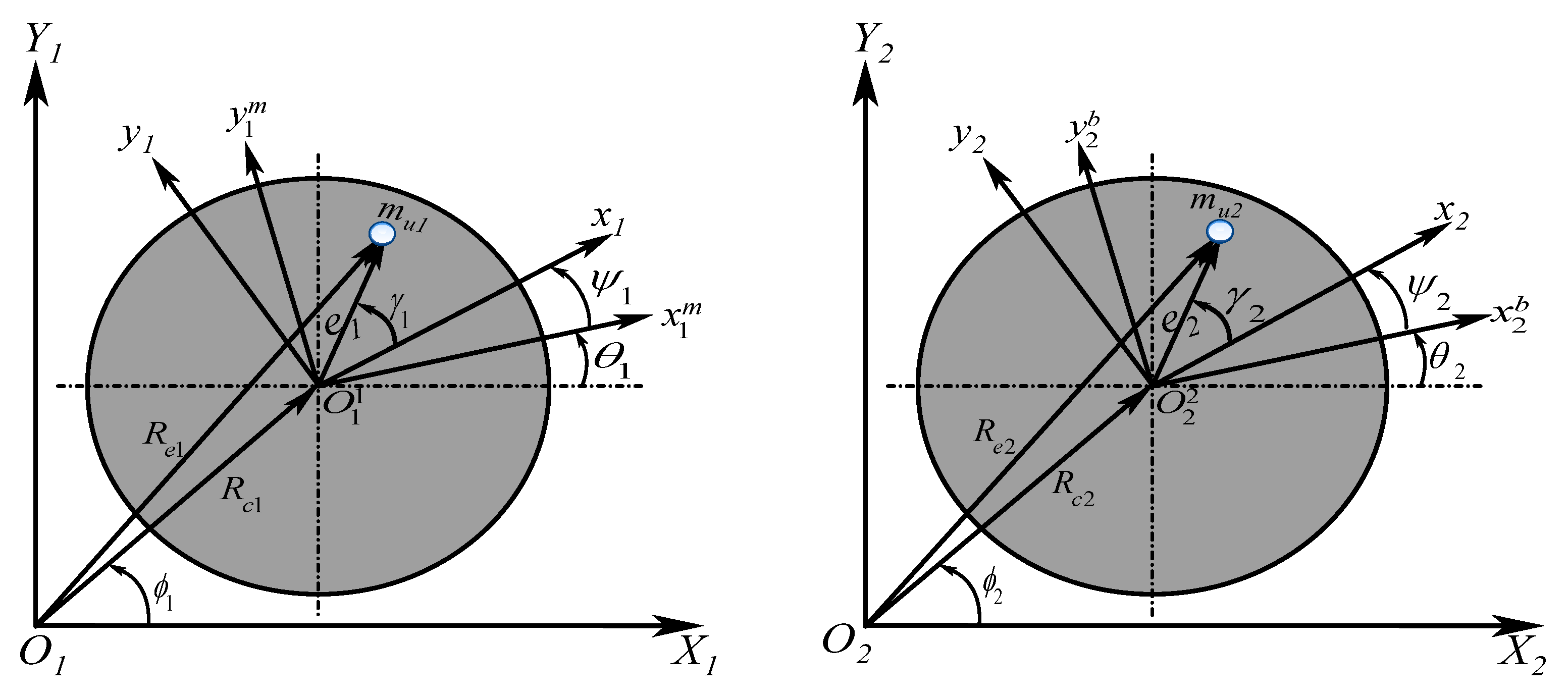


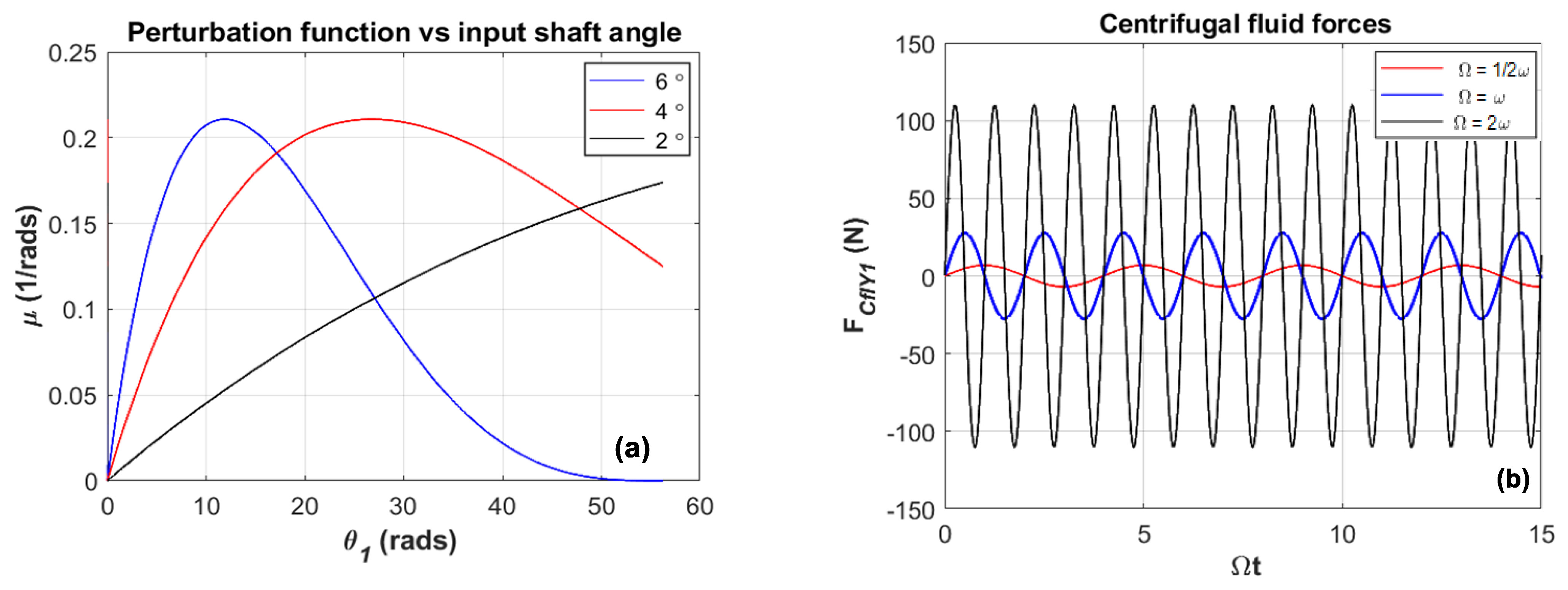

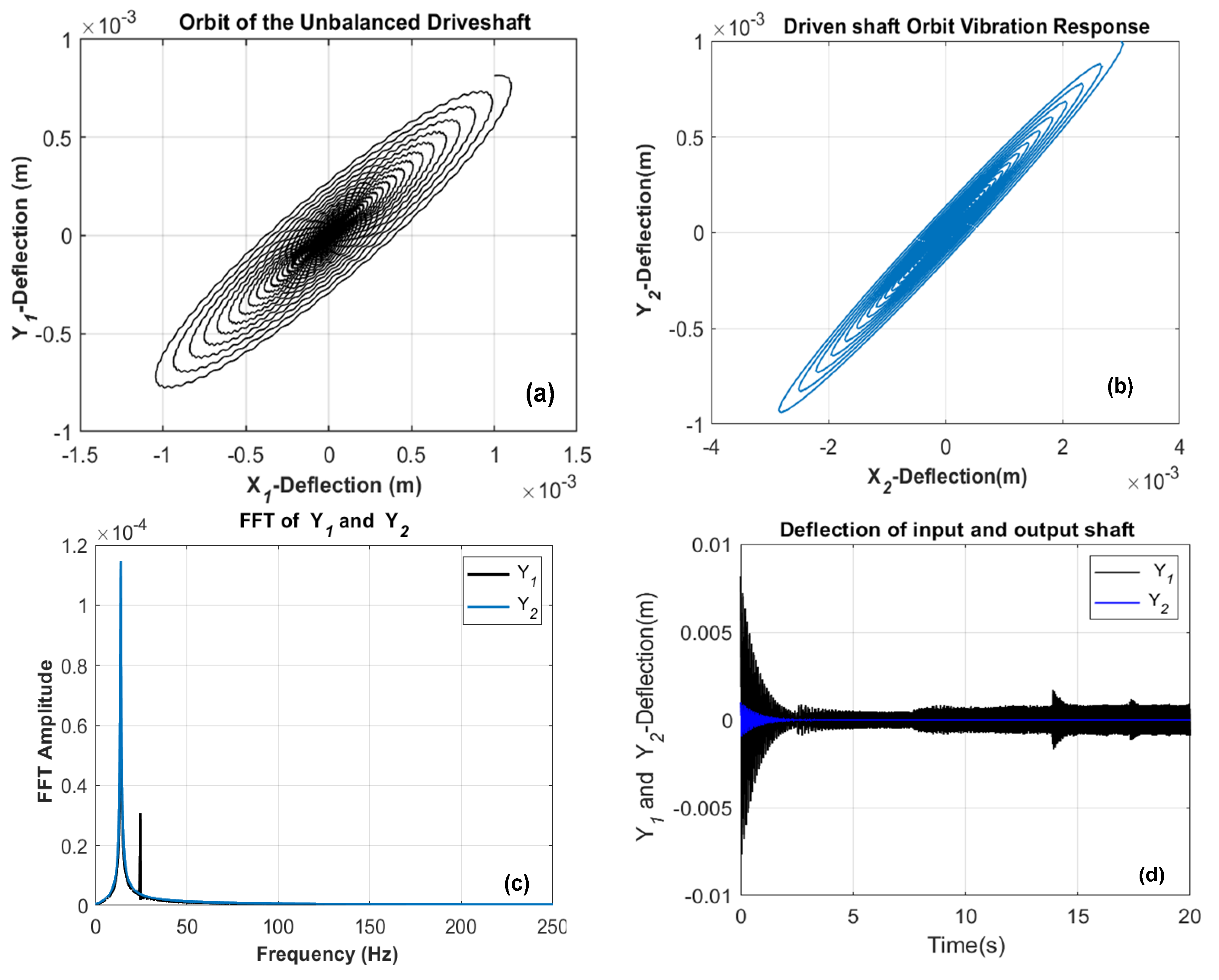
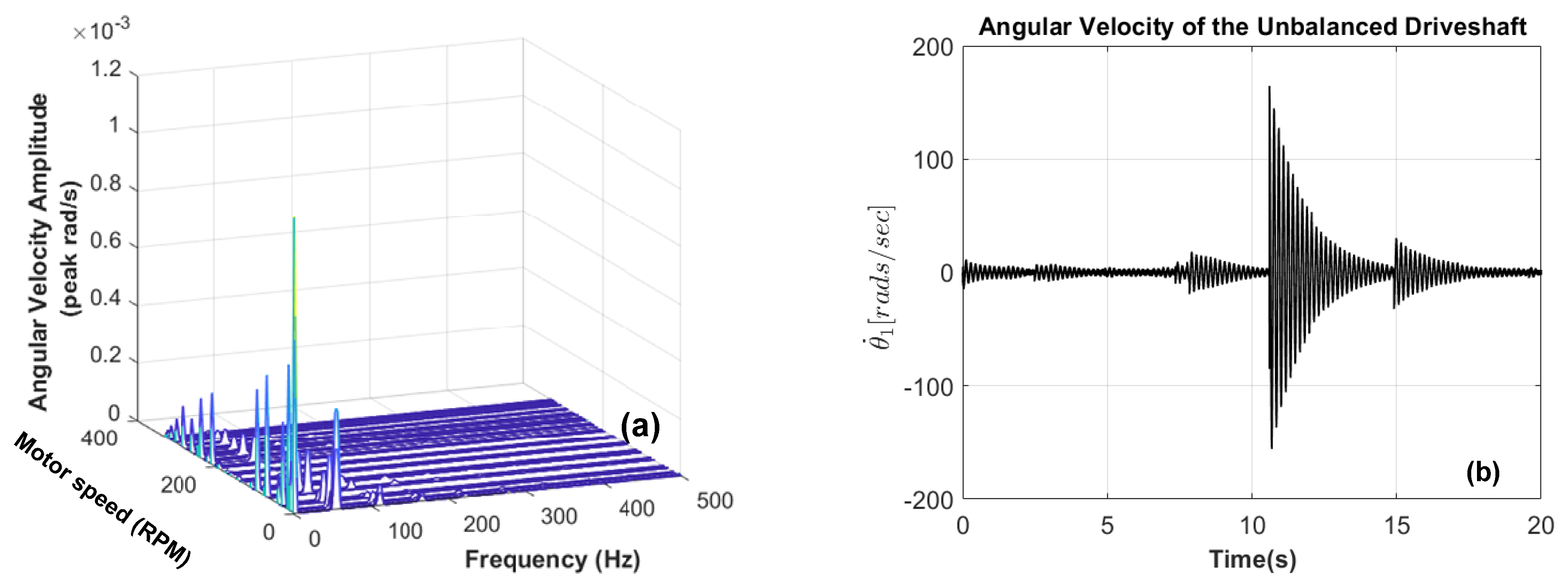
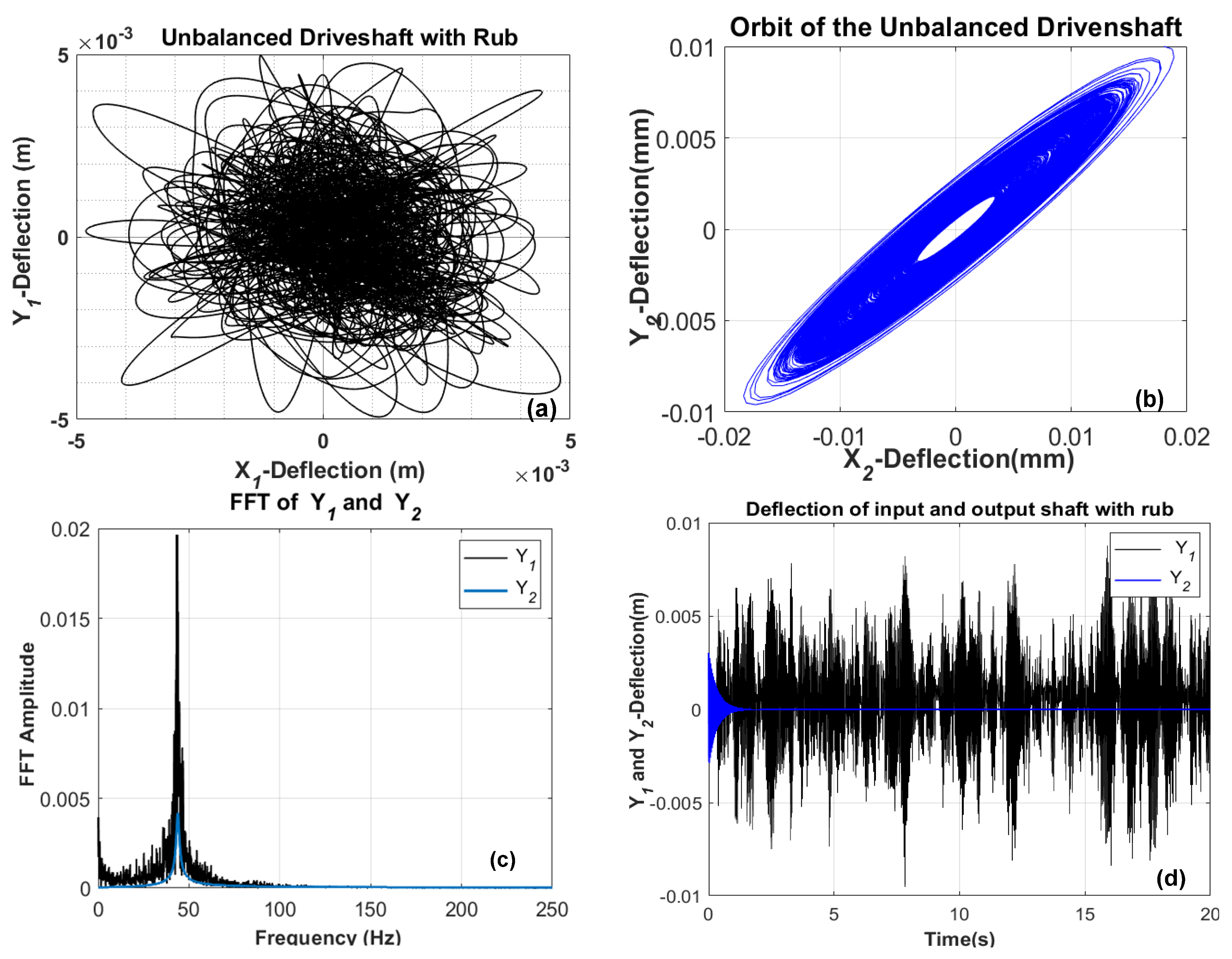
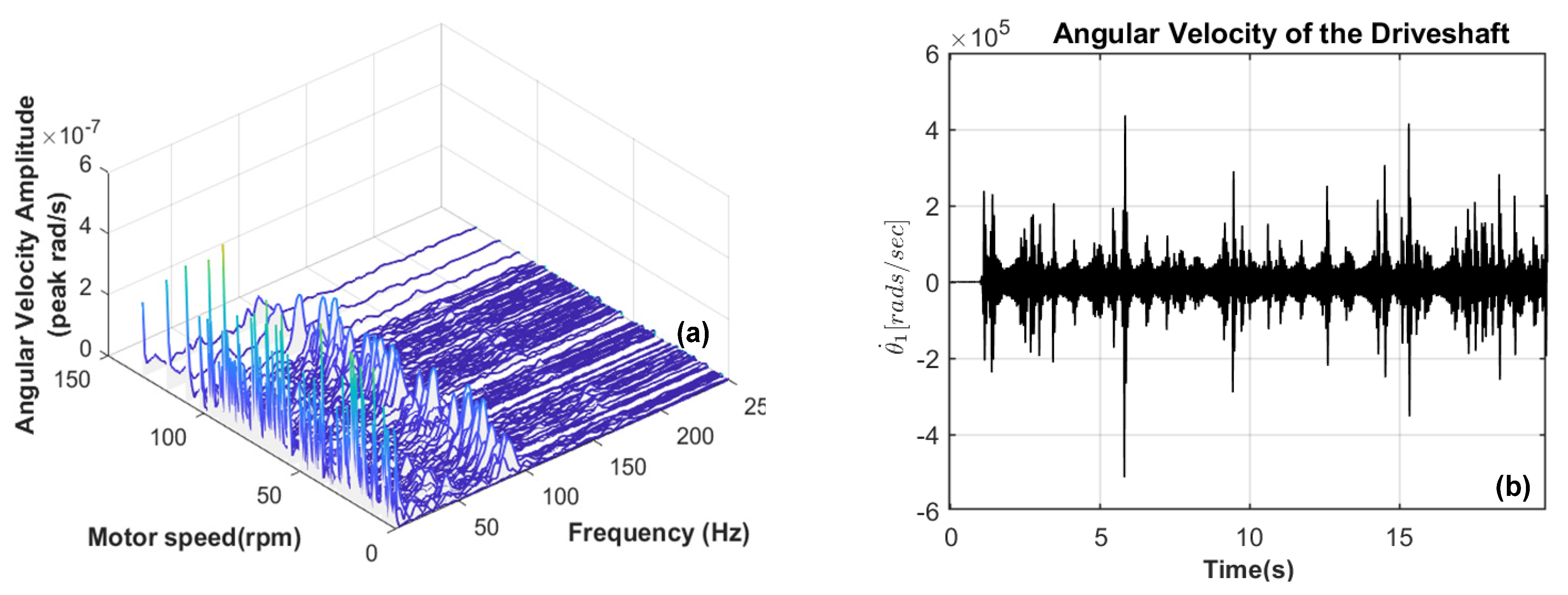
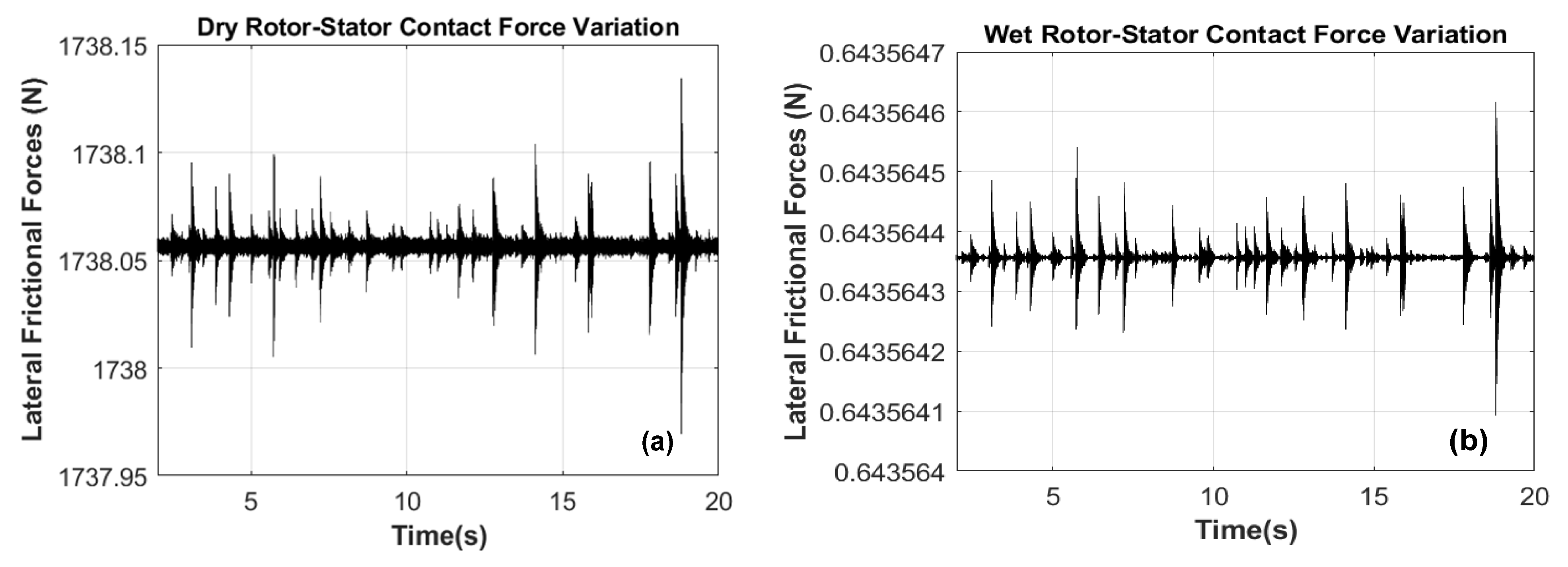
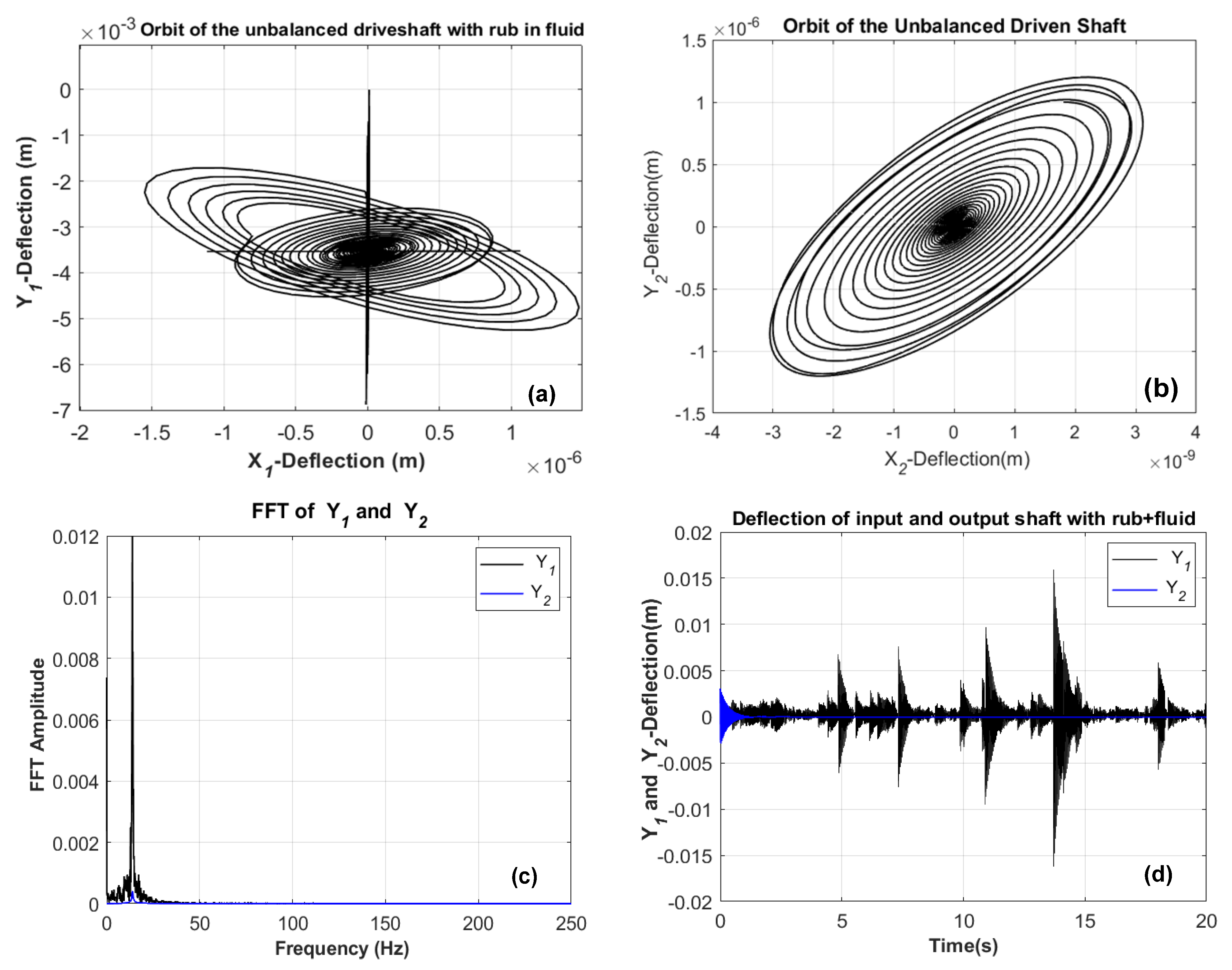
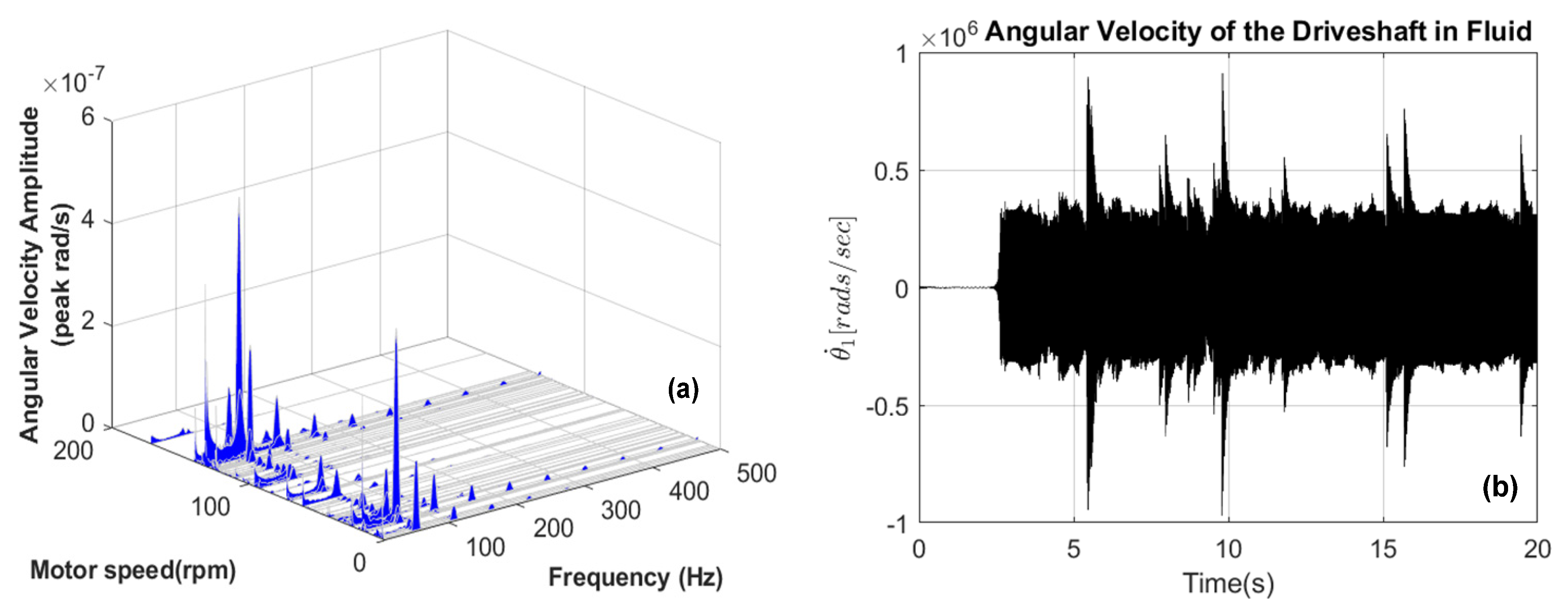
| Shaft Parameters | Value and Units | Shaft Parameters | Value and Units |
|---|---|---|---|
| Length of the shaft (L) | 570 mm | Shaft stiffness K1X | 7.35 × 105 Nm−1 |
| Shaft Diameter (D) | 10 mm | Shaft torsional stiffness K1T | 6.9 kNm−1/rad |
| Shaft torsional damping (C1T) | 90 Nms./rad | Stator stiffness Ks | 8 × 106 Nm−1 |
| Disc thickness (Ddisc) | 10 mm | Discs | Value and Units |
| Disk moment of inertia (JD) | 0.1861 kg m2 | Mass (M) | 16.845 kg |
| Motor moment of inertia (JM) | 10.1861 kg m2 | Eccentricity mass (mu) | 0.25 g |
| Friction coefficient () | 0.2 | unbalance eccentricity (e) | 10 mm |
| Hooke’s joint angle () | Radial clearance (δ) | 2.35 × 10−5 m |
| Parameters | Value |
|---|---|
| Oil T° | 20 °C |
| 36.86 rad/s | |
| Viscosity () | 4.2 × 10−6 m2 /s |
| Mass mfl | 43.82 kg |
| Euler constant | 0.5772156 |
Publisher’s Note: MDPI stays neutral with regard to jurisdictional claims in published maps and institutional affiliations. |
© 2021 by the authors. Licensee MDPI, Basel, Switzerland. This article is an open access article distributed under the terms and conditions of the Creative Commons Attribution (CC BY) license (https://creativecommons.org/licenses/by/4.0/).
Share and Cite
Tchomeni, B.X.; Alugongo, A. Vibrations of Misaligned Rotor System with Hysteretic Friction Arising from Driveshaft–Stator Contact under Dispersed Viscous Fluid Influences. Appl. Sci. 2021, 11, 8089. https://doi.org/10.3390/app11178089
Tchomeni BX, Alugongo A. Vibrations of Misaligned Rotor System with Hysteretic Friction Arising from Driveshaft–Stator Contact under Dispersed Viscous Fluid Influences. Applied Sciences. 2021; 11(17):8089. https://doi.org/10.3390/app11178089
Chicago/Turabian StyleTchomeni, Bernard Xavier, and Alfayo Alugongo. 2021. "Vibrations of Misaligned Rotor System with Hysteretic Friction Arising from Driveshaft–Stator Contact under Dispersed Viscous Fluid Influences" Applied Sciences 11, no. 17: 8089. https://doi.org/10.3390/app11178089
APA StyleTchomeni, B. X., & Alugongo, A. (2021). Vibrations of Misaligned Rotor System with Hysteretic Friction Arising from Driveshaft–Stator Contact under Dispersed Viscous Fluid Influences. Applied Sciences, 11(17), 8089. https://doi.org/10.3390/app11178089






